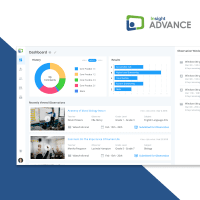
Digital transformation is not just about upgrading technology – it’s about rethinking how your business operates. This fundamentally changes how you deliver value to customers, adapt to market changes, and build an organizational culture.
However, what is often unclear for many business leaders is how to plan and implement a successful digital transformation strategy.
- Which digital technologies should we invest in?
- Who will lead the transformation?
- What will be our future organizational structure?
- How should we prepare for the culture change?
- Will it be valuable for my business?
To answer all these questions and beyond, this article aims to serve as the ultimate guide for businesses rethinking their old operating models and continually evolving.
But first, let’s discuss the basics!
What Is Digital Transformation?
Digital transformation is the process of strategically integrating digital technology to reshape your organization and deliver continuous value.
The concept is not specifically about transforming your IT or technology stack. It’s how you enhance the 3Ps of enterprise success – products, processes, and people – by integrating technology into every aspect of your business.
To truly implement digital transformation, businesses must adopt a digital-first culture throughout the organization. Encourage your workforce to continuously challenge old ways of thinking, embrace experimentation, and become comfortable with taking risks.
| “At least 40% of all businesses will die in the next 10 years… if they don’t figure out how to change their entire company to accommodate new technologies.” — John Chambers, former Cisco CEO |
Why is a Digital Transformation Strategy Important for Your Business?
Executives globally suggest that the primary advantages of digital transformation include better operational efficiency (40%), faster time to market (36%), and better alignment with customer expectations (35%).
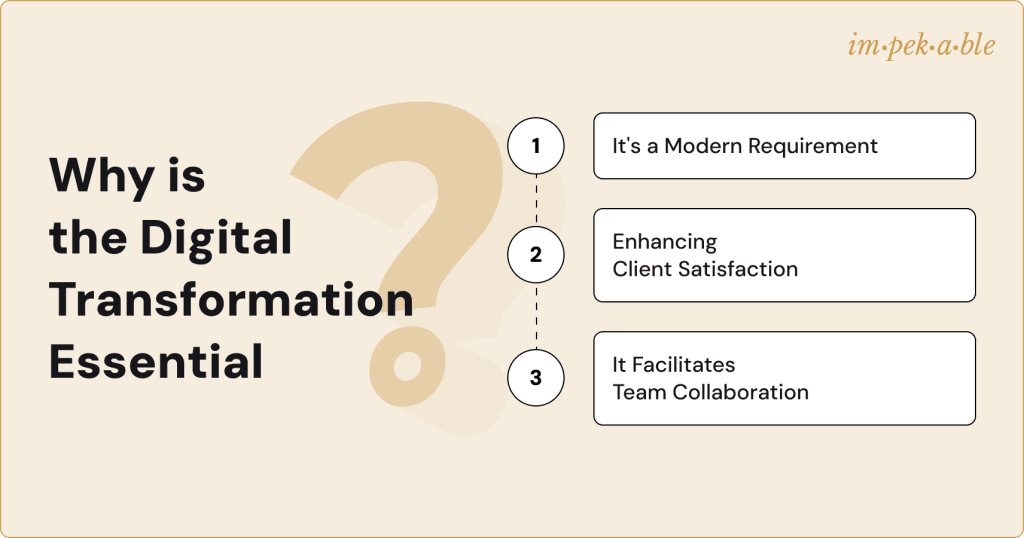
Here’s how digital transformation benefits your business:
- Improved Agility: Whether it’s adjusting to new customer demands, responding to competitive pressures, or scaling operations, a robust digital product strategy allows your organization to be more agile.
- Competitive Advantage: Without digital transformation, your business risks falling behind competitors who are leveraging it to innovate and adapt. Moreover, using advanced technologies allows you to differentiate your offerings and capture the attention of the tech-savvy market.
- Better Decision-Making: Data is at the heart of digital transformation. The transformation integrates advanced data analytics and business intelligence tools into your operations. As a result, you can better anticipate challenges and capitalize on new opportunities with confidence.
- Enhanced Customer Engagement: With digital tools such as CRM systems or AI-driven marketing, you can tailor interactions to individual customer preferences. When a customer feels heard, it increases brand loyalty.
- Increased Productivity: Digital solutions improve team collaboration and workflow management. This results in higher productivity levels and better overall performance.
What are the Five Pillars of a Successful Digital Transformation
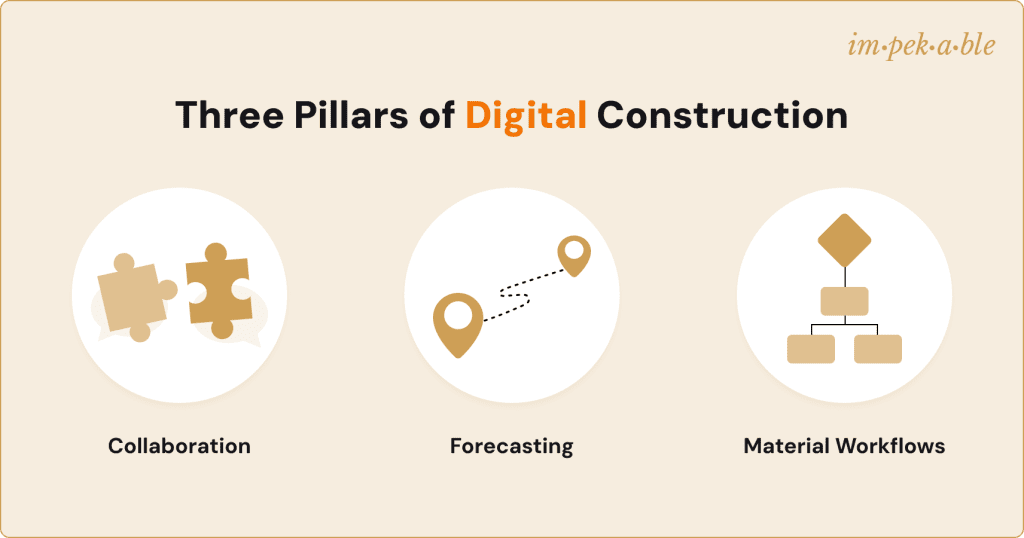
A winning digital transformation hinges on aligning every element perfectly. Here are the five essential pillars that should be a part of your digital transformation strategy.
#1 Technology
In the current digital scenario, reimagining your IT infrastructure is a must. This includes modernizing legacy systems and investing in technologies that add significant value to your business. Here are some examples:
- Cloud Computing: Migrating to the cloud helps you quickly adjust resources to meet fluctuating demand. Cloud platforms also support disaster recovery and data backup, which helps with business continuity in case of disruptions.
- Microservices Architecture: By breaking monolithic applications into smaller, independent services, you enable faster updates, quicker deployments, and better fault isolation. This approach supports agile development and continuous integration, which results in more resilient systems.
- Containerization: Tools like Docker and Kubernetes help you deploy your application in any environment without needing to configure it for different environments. When applied properly, it provides the portability of “write once, run anywhere.” which enhances the DevOps processes.
By taking a tech-first approach through digital transformation, you ensure sustained growth and stay ahead of the curve.
#2 Processes
Currently, available technologies can automate around 45% of tasks people are paid to do. This translates to roughly $2 trillion in annual wages in the US alone.
While it’s commonly believed that automation mostly impacts low-paying jobs, even high-paying positions like financial managers and top executives have a surprising number of tasks that can be automated.
For instance, implementing automation tools can help you eliminate repetitive tasks like data entry and report generation. It reduces the risk of human error while accelerating operations.
You can also use digital solutions to transform how the work gets done across your organization. For example, integrating an enterprise resource planning (ERP) system streamlines inter-departmental communication. As a result, tasks move smoothly from one stage to the next, which prompts faster decision-making.
#3 Customer Experience
Customers now demand to be at the forefront of every brand interaction. And the rising customer expectations have become the primary force driving digital transformation efforts.
So, you must create a personalized customer experience across all brand touchpoints and utilize intelligent tools that provide real value.
This can be as simple as integrating AI-powered chatbots into your customer service strategy to provide 24/7 support. Or, you may deploy Customer Relationship Management (CRM) systems to centralize customer data and personalize communication.
These technologies allow you to form deeper connections and anticipate customer needs while providing relevant solutions.
#4 Leadership
Another important aspect of driving a successful digital transformation is who sits in the driver’s seat. Form teams that include leaders from different departments to ensure diverse perspectives and expertise.
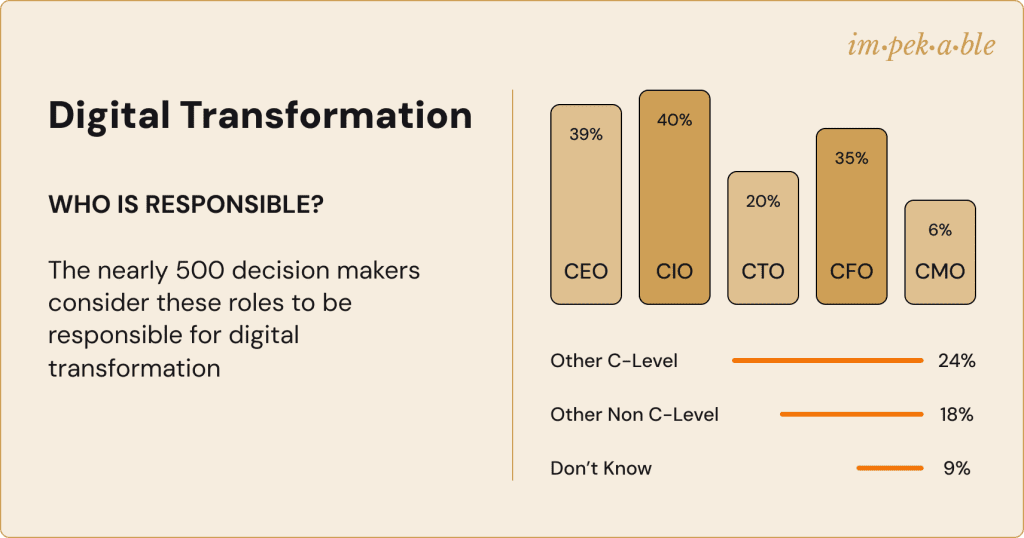
Top Leadership Roles in Digital Transformation
It’s also a good idea to engage key stakeholders early and often. This forms clear communication and alignment on goals that help secure the needed support.
#5 Culture
Creating a digital-first culture is essential to achieve an organization-wide transformation. In fact, businesses that focus on cultural transformation are 5x more likely to achieve breakthrough performance than those that do not.
A good point to start is to promote an environment of experimentation and innovation. Encourage employees to explore new ideas, test solutions, and learn from failures. You must also adapt management practices to support a digital mindset within your employees.
Remember, the employee experience during the digital transformation will make or break the effectiveness of your operational transformations.
Step-by-Step Guide to Plan and Execute a Digital Transformation Strategy
Implementing a digital transformation is exciting, but it’s natural to feel unsure when undertaking something so new and vast. It’s important not to let this uncertainty hinder progress.
Follow the following 9 steps to strategize and execute your digital transformation successfully.
#1 Assess your Current State
The first step is to assess your existing technology infrastructure and processes. Understanding where you stand today is important to determine where you need to go. This step involves three critical activities:
1. Evaluating Current Technology Infrastructure
Start by auditing your existing technologies. This includes taking stock of your hardware and software and assessing how well these elements support your business needs.
Here’s how to do it.
- Create a detailed, up-to-date list of all technology assets
- Analyze the performance and reliability of your systems by reviewing historical data such as uptime, system failures, response times, and more
- Assess how well current systems integrate and the potential new technologies you plan to introduce
- Review whether your current security protocols can scale to protect new digital tools and platforms
- Assess the extent to which your organization is prepared for cloud adoption
2. SWOT Analysis for Process Maturity
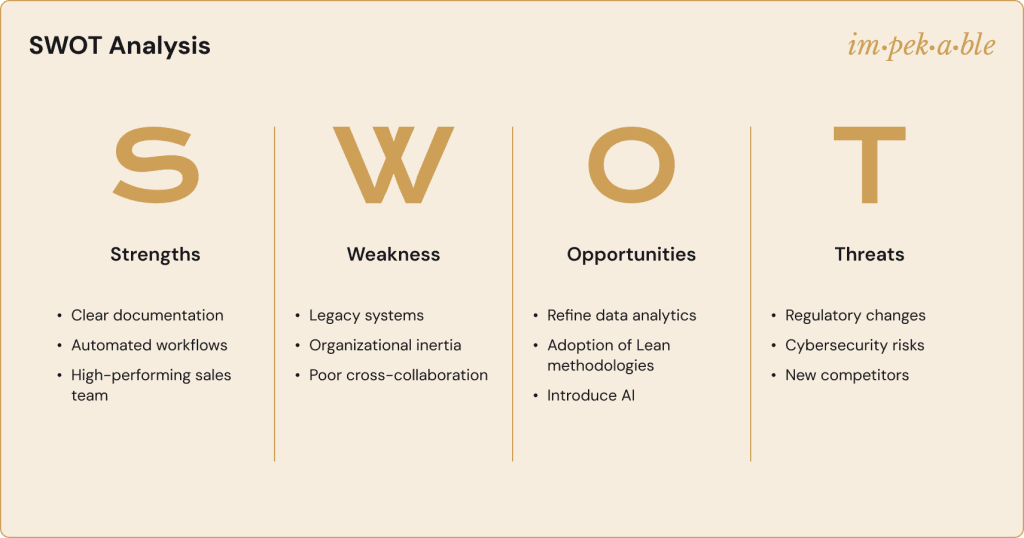
The next step is to analyze the SWOT – Strengths, Weaknesses, Opportunities, Threats – for your current processes.
To do this:
- List the processes that are currently working well. Highlighting these will give you an idea of where you can build momentum and expand operational capabilities.
- Once done, identify the limitations in your current processes. Is there a lack of automation or poor data analytics capabilities? Are there skill gaps within your team that prevent efficient operation? Documenting these weaknesses will help you target areas needing immediate attention.
- Now, it’s time to explore areas where digital transformation can introduce efficiencies or open new growth opportunities.
- Acknowledge internal and external risks that could disrupt or delay your transformation efforts. Finally, form clear strategies to mitigate these risks.
3. Gap Analysis
This method helps you define your digital vision and pinpoint where gaps exist. Here’s how:
- Start by clearly articulating your future digital goals. Ask yourself, “What does success look like?” The clearer your vision, the easier it will be to create a roadmap for your transformation.
- Compare your current organizational state with your desired future. Map out the technologies and resources you’ll need to reach your digital goals. Also, identify where your organization currently falls short. For instance, if your goal is to leverage artificial intelligence (AI) for better decision-making but your current systems lack advanced data analytics capabilities, that’s a clear gap to address.
- Once you identify the gaps, develop a detailed, phased action plan for closing them. Prioritize based on the most critical areas and align resources and timelines accordingly. This may include technology upgrades, employee training, or revisiting vendor relationships.
#2 Set Your Objectives
Setting clear objectives is the foundation of a successful digital transformation. Ensure that everyone in the company understands:
- What you’re trying to achieve
- Why it’s important
Remember to set goals that you can track and measure. Vague goals like “improve efficiency” aren’t enough. Instead, attach numbers to them. For instance:
- Increase website traffic by 25% within six months using a revamped digital marketing strategy
- Reduce customer service response time to under 2 minutes by implementing AI-driven chatbots
Digital transformation is an ongoing process. So, it’s important that you regularly review your objectives and adjust them if needed.
#3 Design a Digital Transformation Strategy
Now that you have assessed your current state and defined your goals, it’s time to design a well-thought-out digital transformation strategy.
Ideally, the right kind of strategy should balance short-term achievements with long-term goals for continuous value.
Here are some tips for designing an effective strategy:
1. Creating a Phased Approach
A phased approach breaks the transformation into manageable steps. It keeps the project moving forward while showing quick wins to maintain stakeholder support.
So, you’ll create a roadmap that outlines the sequence of initiatives, their timelines, and the key dependencies. It should include:
- Short-term wins to build momentum
- Medium-term projects that require more time but show substantial progress
- Long-term goals that are more complex and align with the overall business strategy
2. Prioritization of Initiatives
You can’t focus on all projects at once. Prioritizing them ensures that you allocate resources to the most impactful and feasible initiatives.
To do this, evaluate how each initiative will affect your core operations, customers, and revenue. For instance,
- Will upgrading your data systems improve decision-making?
- Will automating a process reduce costs and speed up delivery times?
Also, consider factors such as:
- Availability of skilled personnel
- Existing technology infrastructure
- Potential risks or roadblocks
Once done, use a prioritization matrix to visually map out projects based on their impact and feasibility, such as:
- High-impact, high-feasibility initiatives should be prioritized immediately
- Low-impact, low-feasibility initiatives may not be worth pursuing
3. Budgeting and Resource Allocation
Proper budgeting and resource planning are essential to avoid delays or failures. Make sure you account for all costs and allocate resources wisely.
- Conduct a Cost Analysis: Break down the costs for each initiative. Consider both direct costs (software, hardware, training) and indirect costs (time spent by employees, disruptions to regular operations). This detailed analysis will help prevent surprises later.
- Prepare a Contingency Budget: Plan for the unexpected. Delays, tech issues, or even team turnover can lead to extra costs. A contingency budget (typically around 10-20% of the total budget) ensures you’re prepared to handle these without derailing the entire strategy.
- Estimate ROI: Calculate the return on investment (ROI) for each project. How much will the company save? How much revenue will the initiative generate? Having clear numbers allows you to justify the budget to stakeholders and shows the tangible benefits of digital transformation.
Don’t forget to present a compelling business case using the above pointers when seeking approval from senior management.
#4 Implement the Digital Technologies
With a solid strategy in place, the next crucial step is to select and deploy the right digital technologies to drive your transformation.
Below are detailed steps to help guide you through the process:
1. Technology Selection
Focus on technological solutions that align directly with your objectives. For example, if your goal is to improve customer service, look for CRM software that can track customer interactions.
Scalability is another important consideration when choosing the right technologies. If you expect your company to expand, select tools that allow you to add users, process more data, or offer new services without a complete overhaul.
When choosing the tools or platforms, it’s also a good idea to consider the security aspects such as:
- Encryption capabilities
- Multi-factor authentication (MFA)
- Compliance with industry standards (like GDPR or HIPAA)
Oftentimes, integration issues cause delays and increase costs down the road. So, before making a choice, remember to check whether the tool can easily communicate with your other software or platforms.
Finally, request demos or trial versions of the tools you’re considering. This gives you a chance to test the software’s functionality and compatibility with your systems before making a full investment.
2. Deployment Strategies
Once you’ve selected your technologies, the next step is deciding how to roll them out across your organization. There are two main deployment strategies to consider:
- Phased Rollout: In this case, you’ll implement new technologies gradually. You start with one department or team before expanding across the entire organization. With decades of product development experience for global brands, it’s a method we favor at Impekable because it minimizes risks and makes troubleshooting easier. Plus, you can quickly learn from real-world usage and gather both employee and customer feedback.
- Big Bang Rollout: This approach involves implementing the new technology across the entire organization at once. While it promises faster results, it’s a much riskier approach. So, we generally advise brands against this method due to the potential complexities. However, if you do choose to go this way, ensure thorough preparation to avoid disruptions.
#5 Structure the Key Roles for Your Digital Transformation
A successful digital transformation requires a well-defined team with clearly assigned roles. Each role contributes unique expertise to ensure a smooth and effective transition. Here’s a step-by-step guide to structuring key roles:
1. Define Roles and Responsibilities
- Technical Teams: Your IT and development teams are responsible for the installation and setup of new technologies. They may also need to create custom software to support the transformation. So, ensure they are prepared to resolve technical audit issues quickly and innovate when necessary.
- Business Units: Each department should identify what they need from the new technologies. For instance, the marketing team might need tools for campaign tracking, while the finance team might need advanced reporting features. Remember to collect their feedback to make needed improvements.
Clearly document everyone’s responsibilities and processes. Ensure all your team members are trained on the new systems and tools. This helps prevent mistakes and boosts confidence during the transformation process.
#6 Optimize Your Processes
The key to a successful digital transformation is to encourage a mindset of continuous improvement. Optimizing your processes helps you get the most out of your digital tools and streamline operations.
Here are two principles to follow:
- Lean: This approach eliminates waste and improves efficiency in your processes. Focus on value-added activities and identify areas where you can automate manual tasks.
- Six Sigma: This principle focuses on analyzing data to identify and remove process variations and ensure consistency, which is particularly important when introducing new digital tools.
A clear and detailed roadmap for change management is essential. It should guide employees through the transformation process. Start by explaining the reasons behind the changes and outlining the positive impact they will have on their daily work.
Lastly, prepare your workforce to adopt the new processes. Invest in training programs that equip them with the skills to work efficiently in a new digital setting.
#7 Choose the Right Digital Transformation Consultant
According to McKinsey, about 50% of all digital transformation initiatives never reach their intended value. On the other hand, only about 10% outperform expectations. This is where a reliable digital transformation consulting firm can help.
These are the professionals who have expertise in areas where your team may need extra help, such as cloud migration or cybersecurity. Here are some criteria to consider for selecting a consultant:
- Experience: Look for consultants with a proven track record in digital transformation, especially within your industry. It’s important that they understand the unique challenges you face.
- Expertise: Ensure that the consultant brings deep expertise in the technologies you plan to implement – whether it’s cloud computing, data analytics, or cybersecurity.
- Proven Results: Ask for case studies or references to demonstrate the consultant’s ability to deliver results. Look for examples where they have helped other organizations achieve measurable success.

Learn how Impekable can help.
#8 Collect and Analyze Data
Data is the backbone of a successful digital transformation. The ability to track, analyze, and act on data allows you to adjust your strategy in real time.
Here’s how to leverage data to measure the success of your digital transformation strategy:
- Implement business intelligence (BI) tools like Power BI, Tableau, or Google Data Studio to track performance metrics, identify bottlenecks, and measure the impact of digital tools on your operations.
- Consider using a Customer Data Platform (CDP) like Segment by Twilio to centralize and manage customer data across various channels. This will give you a more complete view of customer interactions.
- Use feedback loops to continuously refine your strategy. Regularly analyze data to understand what’s working and pivot if necessary.
Focus on the following KPIs when tracking your digital transformation success:
- Value Creation: These KPIs include operational metrics, financial performance, and customer metrics such as customer satisfaction (CSAT), Net Promoter Score (NPS), and customer lifetime value (CLV).
- Team Performance and Engagement: Use metrics like project completion rates, team velocity, and the quality of deliverables to measure team productivity. It’s also important to measure how well your organization is developing critical digital skills, such as product management, software engineering or user experience design.
- Cultural Integration: Use employee engagement scores to measure how well your workforce adapts to the new digital culture.
#9 Refine Your Digital Transformation Strategy
Digital transformation is not a one-time effort—it’s an ongoing process. Changes in market conditions, customer needs, and emerging technologies may require shifts in your approach to remain competitive.
Here’s how to keep your digital transformation strategy on track:
- Establish regular intervals, such as quarterly or bi-annually, to review your digital transformation progress.
- Keep abreast of market trends, emerging technologies, and shifts in customer behavior.
- Continuously explore new technologies and innovations that could benefit your organization.
- Implement pilot programs to test new technologies on a smaller scale before full deployment.
- Adjust your digital strategy in response to internal changes, such as organizational restructuring, as well as external factors.
Based on feedback and new insights, make iterative adjustments to your strategy. This may involve tweaking existing initiatives, launching new projects, or discontinuing efforts that no longer align with your goals.
Examples of Digital Transformation
| Traditional Approach | Digital Transformation | Real-World Examples | Business Outcome |
| Direct mail | Email marketing, personalized ads | Netflix’s personalized recommendations | Netflix’s recommendation engine drives 75% of content watched on the platform |
| Loyalty programs | Mobile apps, gamified rewards | Starbucks Rewards app | Starbucks Rewards brought a whopping 53% of U.S. revenue |
| Social media Insights | AI-driven insights | Coca-Cola’s use of social listening tools | The brand can quickly respond to emerging trends and gain customer insights in real-time |
| Call centers | Chatbots, self-service portals | Bank of America’s Erica chatbot | Erica completed 330 million requests in the first 6 months |
| Data collection | Sentiment analysis, customer journey mapping | Disney introduces MagicBands to understand guest behavior | Disney World was able to increase capacity by 30% using this data analytics system |
| Manual monitoring | AI-powered predictive analytics | General Electric’s use of sensors and AI on jet engines | This step is expected to reduce jet engine failure by one-third |
| Paper checklists | Digital checklists, automated workflows | Boeing uses digital tools to streamline aircraft manufacturing | Boeing’s switch to digital checklists decreases production time by 25% |
| Preventative maintenance | Condition-based maintenance, IoT-enabled alerts | Siemens adds sensors on trains to predict maintenance needs | Reduces maintenance costs by up to 15 percent and ensures fleet availability rates of up to 100% |
| Physical prototyping | 3D printing, digital simulations | Ford’s use of 3D printing to rapidly prototype car parts | This cut development costs by 25% and lead times by up to 94% |
| On-site training | Virtual reality, augmented reality | Walmart leverages immersive learning to train employees | Reduces training time by 95% and gets a 30% boost in employee satisfaction |
| Remote collaboration | Cloud-based tools, video conferencing | Autodesk launched Construction Cloud for clients | General contractors reported 50% time savings and 100% increase in bids |
Why do 70% of Digital Transformations Fail?
64% of business owners say they have increased the funding of digital initiatives. Yet, digital transformations have proven to be notoriously difficult, with only 30% succeeding.
Below are some common reasons why:
- Lack of a Clear Strategy: Many organizations adopt digital technologies without aligning them with the business goals or existing systems. This can be a major barrier in directing your efforts which may render your digital initiatives ineffective.
- Considering It is Only an IT Task: You have planned your digital technologies, so the next logical step is leveraging them. However, what many business leaders forget is digital transformation affects all departments, not just IT. While technology drives the change, it impacts your supply chain, finance, HR, and more. So, for the transformation to succeed, all departments must align and adjust their processes.
- Poor Change Management: Technology is important, but the people dimension is usually the determining factor in digital success. Ignoring organizational inertia can manifest as employee skepticism and resistance to change. This blocks your company’s ability to adapt and progress. On the other hand, with a proper change management strategy, you become 6x more likely to achieve your digital goals.
- Lack of Leadership: Digital transformation must be led from the top. However, driving an organization-wide change is no easy feat. You’ll need a compelling vision, a strategy, and stakeholder support to move forward. Without strong leadership, achieving all these is nearly impossible and your company may quickly fall into technical debt. This is where the CEO, with their broad oversight of all departments, becomes the key. Alongside other senior executives (e.g. CIO, CDO, etc.), they must ensure cross-functional alignment and guide strategic decisions.
- Failing to Transform IT Infrastructure: Even with everything in place, technical execution is often where many digital transformations fail. Misalignment in IT planning, poor system integration, or the lack of talent can crush your progress. This is why many businesses often choose to partner with experienced digital transformation consultancy firms to achieve their goals. The right experts help take the burden off your shoulders and transform plans on paper into real business success.
If you’re interested to see how Impekable can help your brand, you can request a free consultation here.
Top Digital Transformation Trends for Forward-Looking Businesses
Emerging trends in digital transformation include a greater reliance on AI and ML, a broad shift toward cloud-based solutions, and an emphasis on cybersecurity to optimize business operations.
Let’s discuss some of these key digital transformation trends in detail.
#1 AI Transformation
This is the strategic use of artificial intelligence and machine learning algorithms to automate manual tasks and optimize business operations. These technologies can augment your organization’s human intelligence equivalently, irrespective of the sector you are in.
IDC suggests that by 2025, over 90% of new enterprise applications will incorporate artificial intelligence. These AI-driven apps will make software smarter and more adaptive to changing needs.
In the retail industry, for example, AI can analyze customer data to predict purchasing behavior that allows for targeted promotions. For the finance industry, ML algorithms can detect fraudulent transactions in real-time, saving businesses millions.

Let’s Collaborate and Innovate
#2 Cybersecurity
As businesses increasingly embrace digital technologies, safeguarding sensitive information and systems against cyber threats has become a top priority. Data reveals that, on average, enterprises experience 130 security breaches per year per organization. On top of that, over a third of CIOs anticipate difficulty in finding an appropriate skillset in this area.
As a result, companies are investing in advanced security technologies to protect sensitive information from cyberattacks. This includes adopting multi-factor authentication, encryption technologies, and real-time threat detection systems.
Beyond safeguarding your organizational operations, a robust cybersecurity system also builds trust among your customers as they feel safe sharing their data.
#3 Cloud Computing Strategies
After undergoing a digital transformation, businesses need to implement new systems and technologies quickly. Cloud computing offers the agility to do this seamlessly, even as your company grows.
To take it a step further, many organizations are embracing hybrid and multi-cloud strategies. This means instead of a single cloud service provider, you diversify the cloud providers to ensure that critical data and applications remain resilient against potential outages.
Cloud computing has also become a pivotal part of the modern workforce, particularly with the rise of remote and hybrid work models. By providing your employees with consistent access to essential resources, regardless of their location, you facilitate seamless collaboration across geographically dispersed teams.
#4 Everything as a Service (XaaS)
The XaaS model, which includes offerings like Software as a Service (SaaS), Infrastructure as a Service (IaaS), and Platform as a Service (PaaS), is reshaping how businesses access and utilize technology.
Instead of investing in costly hardware and software, you can now subscribe to services that provide the same functionalities on demand. This offers businesses the agility to innovate and grow without the burden of traditional IT investments.
One fantastic example of this is our client, Thinfilm. The company significantly boosted the adoption of their NFC chips by implementing six custom applications that simplified its integration.
The applications – including the Thinfilm website, CNECT Platform, Experience Builder, “Tap to Gift” Feature, NFC Scanner, and CNECT.io website – enhanced user experience and streamlined operations. Consequently, their clients were able to launch more effective marketing campaigns and gain valuable data insights.
Throughout the process, Impekable closely collaborated with Thinfilm to drive their desired outcomes. The partnership allowed the brand to leverage the benefits of XaaS while minimizing IT-related complexities.
#5 IoT
The Internet of Things (IoT) enables real-time data collection, remote monitoring, and automation for different industries. Integrating IoT in business operations is not just a trend – it’s a fundamental shift disrupting the status quo.
For instance, in the manufacturing industry, IoT sensors are transforming maintenance strategies. These sensors continuously monitor machinery performance to identify signs of wear or malfunction before they escalate into costly breakdowns.
Retailers can also benefit from the power of IoT to enhance customer experiences. By analyzing data from device sensors, you can tailor customer interactions and offer personalized recommendations based on real-time behavior.
But don’t just take our word for it.
Here’s a real-life example of Pentair, a global leader in water solutions, embracing IoT to improve connectivity between its products and users’ smart devices.
Initially, they faced challenges with poor user experience and app performance. To resolve this, they adopted IoT and partnered with Impekable to develop a unified design system using React Native.
As a result, their applications now:
- Enable homeowners to remotely monitor their pool systems.
- Allow partners to access sales tools.
- Empower technicians with on-site troubleshooting capabilities.
What’s Next?: Way Forward with the Right Digital Transformation Consulting Firm
Digital transformation is a marathon and not a sprint. And it definitely goes beyond just integrating technologies – it’s about ingesting a digital-first culture within your organization.
By systematically assessing your current state, designing a strategic plan, and choosing the right technologies, you set a strong foundation for success. The real key, however, lies in being agile to meet the evolving business needs.
Impekable enhances enterprise digital transformation by leveraging cutting-edge technology that suits your business. With tailored guidance and continuous expert support, we ensure your digital adoption strategies are not just brought to life but thrive sustainably.
To discover how Impekable can lead your organization to digital transformation success today, Get in Touch.
Frequently Asked Questions

Pek Pongpaet
Helping enterprises and startups achieve their goals through product strategy, world-class user experience design, software engineering and app development.
|
Book Free Consultation
-

“Impekable delivered multiple, fantastic options for us… they genuinely cared about the project and our goals.”
Co-founder, JSwipe, acquired by Tinder
Our Case Studies

